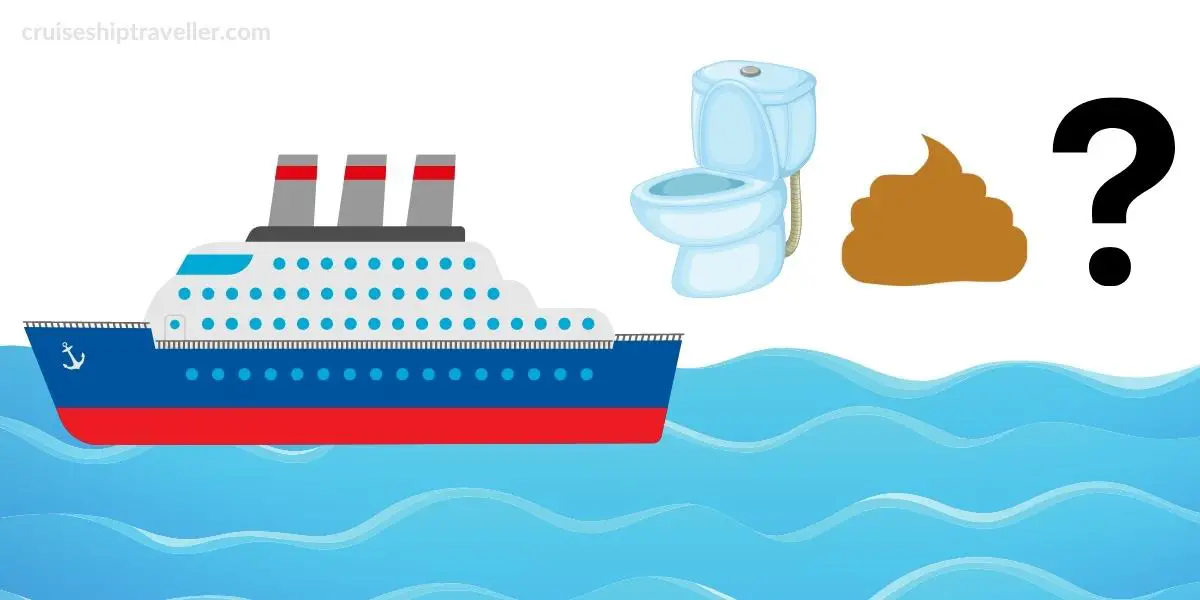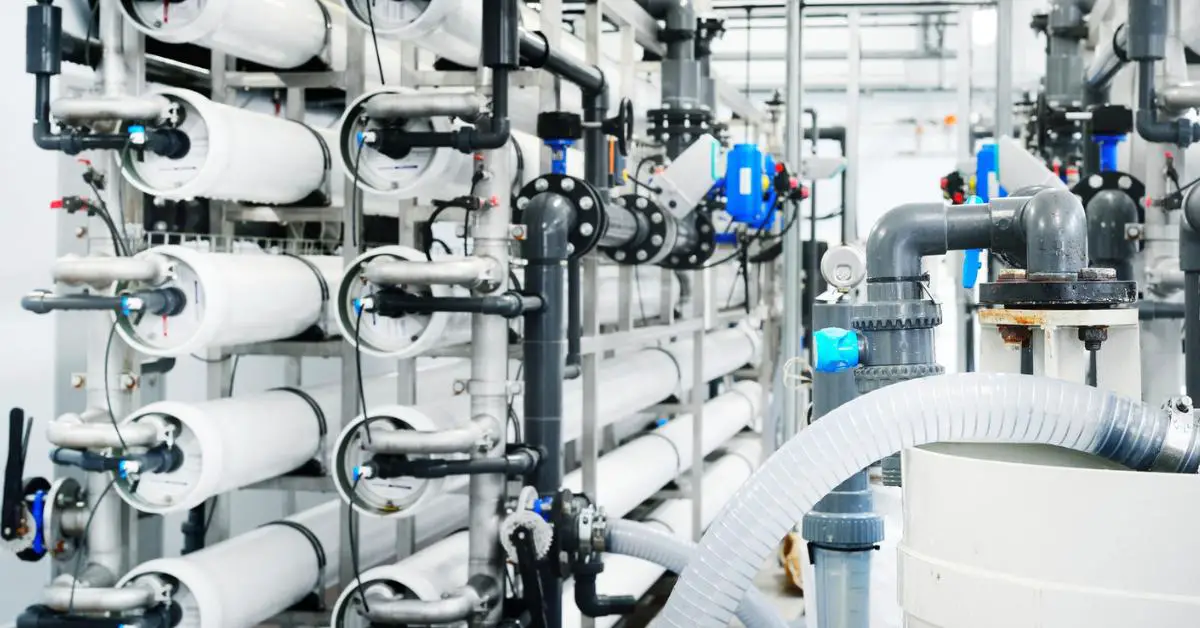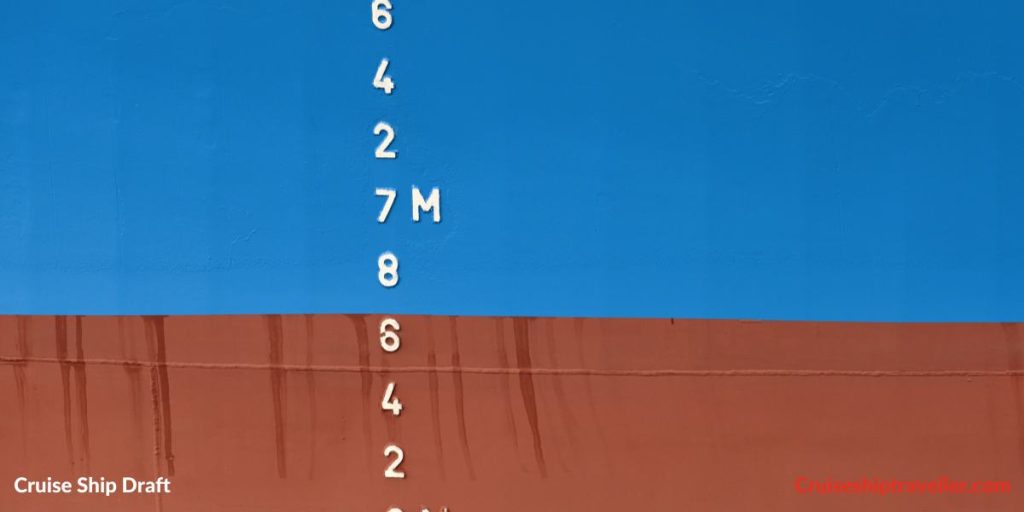Have you ever wondered what happens to human waste on a cruise ship?
Or perhaps been asked by a youngster, “where does poop go on a ship”?
Whatever your age, it’s a question many people wonder about.
Is it just dumped in the ocean, and would that be bad for the environment?
Or is it treated and disposed of responsibly?
With more and more cruise ships being built and seemingly getting ever larger it is certainly a question worth looking into because the amount of raw sewage produced equates to thousands of tonnes a year.

Some of the modern-day mega-cruise ships, including the largest Royal Caribbean cruise ships, can carry well over 6000 passengers and have over 2000 crew members on board. The Royal Caribbean Icon class cruise ships will be even larger.
Do Cruise Ship Toilets Drain Into The Ocean?
To prevent pollution of our marine environments, an IMO convention known as Marpol prohibits cruise ships from dumping or draining toilet water into the oceans.
Marpol Annex IV states:
Source: imo.org
“the discharge of sewage into the sea is prohibited, except when the ship has in operation an approved sewage treatment plant or when the ship is discharging comminuted and disinfected sewage using an approved system at a distance of more than three nautical miles from the nearest land; sewage which is not comminuted or disinfected has to be discharged at a distance of more than 12 nautical miles from the nearest land.“
Where Does Waste Water On A Cruise Ship Go?
Wastewater on cruise ships is separated into two categories on a cruise ship gray water and black water. Toilet water is classed as black water and is treated onboard the ship. Only when the water is deemed safe is it released into the oceans according to specific guidelines.
On a cruise ship, these types of wastewater can be collected and stored in ballast tanks before both being treated separately onboard the ship, as we have outlined below.
Gray Water
Gray water is wastewater from
- Sinks
- Showers
- Galley
- Laundry
Although gray water doesn’t contain the harmful bacteria that black water does, it does contain a broader range of chemicals. Think of the laundry detergents, shower gels, shampoos, and sun lotions that people wash off their bodies.
This is one reason it is not mixed in with the black water because all these different chemicals could negatively affect the early treatment processes using live bacteria, which could be destroyed by unknown contaminants.
Gray water is filtered and discharged in permitted areas away from coastlines.
Sometimes the gray water is added to the final treatment stage of the blackwater when it is chlorinated.
However, it should be borne in mind that gray water is known to contain large amounts of microplastics, originating in particular from large of amounts of laundry, all the bedding, for instance.

What Do Cruise Ships Do With Sewage?
Cruise ships treat raw sewage, otherwise known as black water, within a sewage plant in the engine rooms. It goes through a process of filtration, aeration, settlement, and sterilization before being safely released back in permitted sea areas.
Black Water
Black water is raw sewage discharge that contains or may have come into contact with some forms of solids (including poop). It’s mostly water from toilets.
This includes:
- Feces (poop)
- Urine
- Toilet paper
Black water is dangerous because it contains harmful bacteria and viruses. It is also toxic due to the chemicals added to toilets and any holding tanks it is stored in.
If just released or dumped into the sea it will be environmentally harmful to marine life and also humans if it washes up upon coastlines.
What Do Cruise Ships Do With Black Water?
Both types of wastewater can be stored separately in ballast tanks in the bottom of the cruise ship’s hull.
Ballast tanks are used to help support a cruise ship and lower its center of gravity as well as being used for wastewater, they can be used to keep a ship upright in rough seas and are one means to prevent a cruise ship tipping over too far to one side.
Cruise ships have their own sewage works systems down in the engine room areas.
This is where all the collected black water is sent to be filtered and treated so it’s safe and could in theory, be reused. Much the same as sewage plants work on the land.
It is a 4 step process:
- Screen filtered into a sedimentation chamber (to remove any extra-large objects)
- Aeration – where it’s broken down by aerobic bacteria
- Settlement chamber – where sewage and water separates
- Sterilization – Water is chlorinated and sterilized
You can see an illustration of the process in the video below:
Although the raw sewage is fully treated onboard and results in clean potable water (drinkable), the water itself is not reused onboard. It is stored and later discharged in permitted locations.
Any leftover residues will eventually be safely disposed of ashore.
There are adequate suppliers of fresh water on a cruise ship when it disembarks to last the entire journey and more.

Carnival “Poop Cruise”
In 2013, a fire broke out in the engine room of Carnival Triumph (renamed Carnival Sunrise). Although the fire was extinguished, the events that unfolded led to the event being dubbed the now infamous “Poop Cruise.”
The fire was quickly extinguished by automatic fire prevention systems in place. However, the event caused a loss of power, and the ship lost propulsion, so the ship was not moving.
Initially, passengers were relieved to be told the fire had been extinguished, and the crew was working in the engine room.
However, passengers soon realized the toilets were not flushing, which is a huge problem on a ship with about 4000+ people onboard.
The solution was to give passengers red plastic bags in which to poop and then leave in the corridors.
People who needed to urinate were told to pee in the showers. However, with the cruise ship’s stabilizers not working due to lack of power, the ship rocks from side to side. This resulted in the sewage overflowing from the showers onto the deck floors.
The whole event lasted five days and was subject to 24/7 news coverage.
Subsequently, this led to Carnival installing backup generator systems on all cruise ships in the fleet in an effort to prevent a disaster like this from ever occurring again on a cruise ship.
Further Reading:
- Why Is a Poop Deck Called a Poop Deck? (True Meaning)
- What do Cruise Ships do with Food Waste? (Is it dumped in the ocean?)
- Do Cruise Ships Dump Trash in the Ocean? (What do they do with the garbage waste?)
Frequently Asked Questions
Do Cruise Ships Dump Poop in the Ocean?
Cruise ships are prohibited from dumping untreated sewage or “poop” into the ocean. Cruise ships are equipped with advanced sewage treatment systems that process black wastewater before it is discharged.
Is The Filtered Water On A Cruise Ship Recycled From Toilet Water?
Filtered water on a cruise ship is not recycled toilet water, or any other water from the ship. Toilet water is filtered and processed as black water. Once treated, it is released into the ocean in permitted locations only.
Where Does Toilet Water go on a Cruise?
Toilet water is treated as black water on a cruise ship. It is initially stored in a ballast tank before being treated via an onboard sewage plant in the ship’s engine room. Once the water is deemed safe, it is released into permitted ocean areas.


